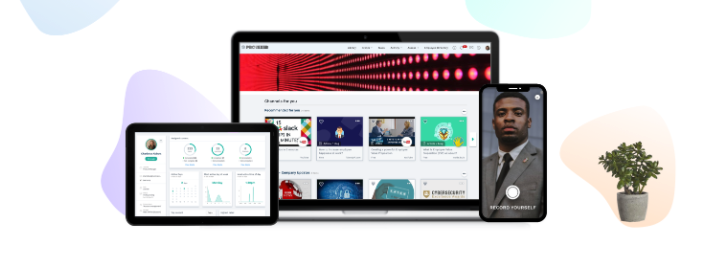How The Right L&D Tools Can Help Your Business
Times are changing. To keep up with the pace, businesses need to change too—and fast. Adapting to the never-ending onslaught that is 2020 takes an L&D program that empowers employees to plan their own learning journey, without losing alignment to key company goals. It takes a decentralised approach to learning that still gives L&D teams the ability to monitor and control engagement and compliance. It takes learning tools that give remote teams the flexibility they need, without descending into chaos. In other words, it takes a unified learning platform.
Warning: Your Current LMS May Cause Cardiac Arrest
Too many businesses are still relying on a centralized Learning Management System (LMS) to manage their employees’ learning. In some ways, it’s easy to see why. LMS platforms give L&D a reassuring sense of control. Using an LMS platform allows you to ensure that all employees have completed compliance training while providing thorough analytics into who has completed each course.
The problem is that LMS tools weren’t designed to support today’s pace of change. In markets driven by information, knowledge is the lifeblood of the company, and your learning tools are the heart. The right learning tools need to pump information around your business, transforming it into a living, breathing, learning organization.
Therefore, if you’re still using an LMS, you’re risking cardiac arrest!
How To Avoid L&D Chaos
While many organizations are trying to update their learning approach by switching from an LMS to a Learner Experience Platform (LXP), it isn’t always that easy.
At Learn Amp, we were so convinced that a decentralised approach to learning was the future, we started off by building an LXP. However, we quickly realized that a pure LXP didn’t meet the needs of businesses completely, any more than a pure LMS does.
LXPs allow an individualized learning journey, which is great—but we don’t only learn as individuals. It can be hard with most LXPs to build a truly cohesive learning experience, or to promote collaborative team learning. Worse, learners are not always that great at driving their own learning journey. New hires may be used to having learning dictated from on high and may not seek out learning resources off their own bat. People get busy and may not make time to learn.
As with most things in the complex world of L&D, it’s vital to find a balance—in this case, between a decentralised approach that promotes employee autonomy and a centralized approach that ensures cohesion.
4 Top Tips For Creating A Balanced L&D Program
Here are our 4 top tips for creating a balanced L&D program that adapts to today’s challenging business environment:
1. Trust Your Employees
If we’ve learned anything this year, it’s that people are extraordinarily resourceful, adaptable and driven. Businesses around the globe have seen their employees rise to unimaginable challenges to keep the lights on.
It’s time to trust your employees to manage their own learning journey. Learning tools that support a decentralised approach to L&D can help increase employee engagement, make sure that all learning resources are relevant and timely, promote innovation and curiosity, and support a self-driven approach to performance that will ultimately drive bottom-line results.
Set up your learning to offer self-serve learning resources. Support your people to design and plan their own unique learning pathways. L&D can help by defining milestones and success markers to make sure that nobody gets left behind.
2. Encourage User-Generated Learning Content
With the right tools in place, any user can create content to drive their own development and create their own pathways. They can then share that information as part of a knowledge community. Not only will this enrich the overall company knowledge base, but it can also act as a great motivator for employees to engage with learning. For example, every user-generated piece of content could show the user’s name and photo, thus offering social recognition for those putting in the effort.
In this context, L&D can act as a curator, reviewing and approving all user content before it is shared to make sure that it is appropriate, on-brand, and valuable. They can also maintain a centralized organization by deciding where each new learning resource should sit, adding tags to make sure the information is easily searchable.
3. Personalize Your Learner Experience
An LMS tends to present users with a one-size-fits-all view of learning. While this is great for creating a cohesive employee experience, it doesn’t treat people as individuals.
With a unified learning experience platform, you can personalize what each person sees when they enter your learning platform. You could segment users based on their start date so new hires don’t get overwhelmed with information. Or you could segment based on role, team, learning history—or anything else that suits your strategic priorities.
This doesn’t mean you have to drop compliance, however. You can still make sure that everyone has to complete certain key training programs, even automating reminders and sending notifications to managers to chase team members as needed.
4. Build A Learning Community
With a shared LMS, your L&D program relies heavily on a few people who contribute, either by creating or sourcing learning content. This not only places a huge administrative burden on the L&D team, it also means that a handful of people are the only ones influencing the learning of your entire company. On the other hand, with an LXP, while individuals can control their own experience and access to learning, it’s much harder to build up a sense of shared and communal knowledge.
With a unified learning platform, you get the best of both worlds. By building a learning community, learning itself becomes a communal activity. Not only do you benefit from user-generated knowledge, but people can work on learning content collaboratively, creating learning resources that can help people with multiple learning styles and needs.
It’s not just content, either. A unified learning platform like Learn Amp lets you set up an internal directory that showcases your in-house experts. This way, knowledge doesn’t just stay with a particular individual and disappear when they leave. Rather, each individual becomes an internal coach, passing on their knowledge to other team members.
While this is always important, it becomes critical when working remotely. Employees can’t just ask for the information they need in passing, or on a coffee break. They need a central directory that points them to either a learning resource or another employee who can help them.
Summing Up
Today’s businesses need a decentralised approach to L&D that keeps pace with the rate of change. If you’re using an LMS, you can’t move fast enough, and knowledge can easily get blocked. However, if you switch to an LXP, your employees are more empowered to manage their own learning, but at a cost. You lose the cohesion of an LMS approach, and it becomes harder to monitor and control employee learning.
The only solution, we’d argue, is to choose a tool that brings together the best of both worlds. With a unified learning solution, L&D teams become curators, providing oversight, compliance and coherence to a vibrant learning hub. Users can plan their own learning journey but also work together as part of a learning community. Your learning platform becomes the true heart of your business.





